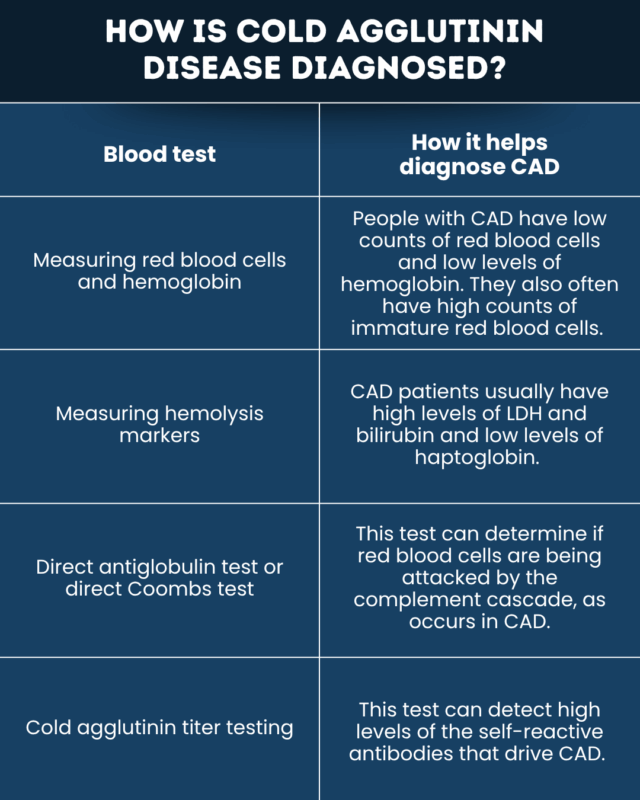
Diagnosis of cold agglutinin disease
Last updated Sept. 25, 2025, by Marisa Wexler, MS.

Accurately diagnosing cold agglutinin disease (CAD), a rare autoimmune condition, is crucial to guiding and starting appropriate treatment. The disease is marked by self-targeting antibodies, called cold agglutinins, that target red blood cells at low temperatures, resulting in their destruction, or hemolysis. This leads to anemia (low red blood cell counts) and circulatory problems that cause the disease’s symptoms.
CAD symptoms to look out for
A diagnosis of cold agglutinin disease starts with a healthcare provider carefully evaluating a person’s medical history to look for signs and symptoms of CAD. Symptoms that may prompt a CAD evaluation include:
- fatigue
- weakness
- dizziness
- shortness of breath
- rapid heartbeat
- pale skin
- jaundice, or yellowing of the skin and whites of the eyes
- dark urine
- unusual pain or discoloration of the extremities in response to cold.
Because these symptoms are not specific to CAD alone, a detailed and comprehensive report of all signs and symptoms from the individual will help the physician narrow down possibilities and order the right tests.
Initial testing
Once a person is suspected of having the disease, the CAD diagnosis process usually starts with blood tests to look for signs of hemolytic anemia, a CAD hallmark where red blood cells are destroyed faster than they are made. Hemolysis blood tests used for CAD screening often measure:
- Red blood cells and hemoglobin: The number of red blood cells is reduced in CAD. Hemoglobin, the protein in red blood cells responsible for carrying oxygen, is typically found at reduced levels in people with CAD. Hemoglobin levels are commonly used as a proxy for red blood cell counts.
- Hemolysis markers: Hemolysis is typically characterized by higher-than-normal levels of bilirubin, a waste product of hemolysis, and lactate dehydrogenase, an enzyme abundant in red blood cells. It is also marked by reduced haptoglobin, a protein that binds to free hemoglobin in the blood.
- Immature red blood cells: These cells, known as reticulocytes, are usually elevated in people with CAD as the body tries to compensate for the loss of red blood cells.
If initial tests show changes consistent with hemolytic anemia, specialized CAD blood tests can confirm the diagnosis.

Specialized blood tests for CAD
When cold agglutinins bind to red blood cells, they recruit a part of the immune system called the complement cascade, ultimately leading to hemolysis. Diagnostic CAD tests typically assess this process and consist of:
- direct antiglobulin test (DAT), also known as the direct Coombs test, which looks for specific antibodies and complement proteins bound to red blood cells
- cold agglutinin titer testing, which can measure the titers, or levels, of cold agglutinins in blood.
A CAD diagnosis can usually be confirmed if DAT testing shows a complement protein called C3d bound to red blood cells and the cold agglutinin antibody test shows high titers.
If other results are obtained, additional testing may be performed to look for a type of autoimmune hemolytic anemia (AIHA) other than CAD. AIHA comprises a group of diseases where the immune system abnormally attacks red blood cells.
A blood smear, in which a drop of blood is spread thinly on a glass slide for observation under a microscope, is also often conducted to identify red blood cell clumps, a hallmark of CAD.
In some cases, a thermal amplitude test may be conducted to determine the thermal amplitude of the cold agglutinins or the highest temperature at which the antibodies are active. This test isn’t required to diagnose CAD, but it may inform treatment decisions, as a higher value will likely cause more severe disease.
Identifying underlying causes
Identifying the underlying cause of CAD is key to guiding treatment decisions. CAD can be divided into two types:
- primary CAD, caused by the abnormal but noncancerous growth of antibody-producing immune B-cells
- secondary CAD, which occurs as a complication of other health problems, such as infections, cancer, or other autoimmune diseases.
Primary CAD may be managed with supportive care, preventive measures to avoid cold exposure, and therapies to suppress the immune system. In contrast, to treat secondary CAD effectively, it’s usually necessary to address the underlying disorder.
Tests that may be conducted to determine the type of CAD include:
- blood tests to look for specific infections
- imaging tests such as CT scans to look for signs of cancer
- bone marrow biopsy to look for abnormal B-cell growth typical of CAD.
Ruling out other conditions
An important part of the diagnostic process is ruling out other disorders that can cause similar symptoms. This is called a CAD differential diagnosis.
Conditions that may need to be ruled out to diagnose CAD include:
- other types of AIHA
- hereditary forms of anemia
- drug-induced immune hemolytic anemia.
Next steps after a diagnosis
After someone is diagnosed with CAD, they will work with their healthcare team to develop a care plan. Specific steps for managing the disease will vary from person to person. Some people living with CAD may be able to manage the disease simply by avoiding cold exposure, but others may require medical intervention to manage symptoms.
Patients are advised to have in-depth discussions with their care team about available treatment options to determine an approach that makes sense for their situation. Both patients and clinicians need to be transparent and honest during these discussions so that everyone involved clearly understands all options and plans.
Cold Agglutinin Disease News is strictly a news and information website about the disease. It does not provide medical advice, diagnosis, or treatment. This content is not intended to be a substitute for professional medical advice, diagnosis, or treatment. Always seek the advice of your physician or other qualified health provider with any questions you may have regarding a medical condition. Never disregard professional medical advice or delay in seeking it because of something you have read on this website.
Recent Posts
- Oral therapy iptacopan eases anemia in CAD patients: Small trial
- When living with CAD, even a short trip can be a nightmare
- Real-world study confirms long-term safety of Enjaymo for CAD
- After months of fatigue, feeling better is what I want for Christmas
- Man’s case shows bacterial lung infection can ‘provoke’ clots, CAD
- Living with cold agglutinin disease involves cruel curveballs
- Gastric lymphoma found to be hidden cause of refractory CAD
- New CAD treatments, like reading progress, prove growth is possible
- ANX1502 proof-of-concept trial to wrap up next year, Annexon says
- What if Sadie Hawkins Day made me the doctor?


